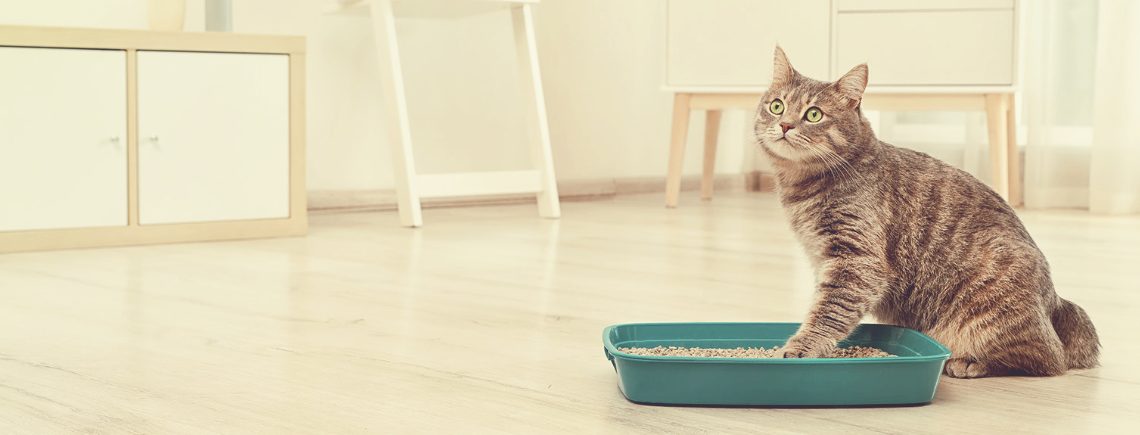House Training your Cat
House training your cat or kitten is a simple and straightforward process, as they are naturally clean animals that don’t like to soil their territory. They usually like to go toilet in the same spot, which makes house training that much easier.
Young kittens would have learned how to use a litter box by watching their mother, however if they have not been trained yet, you will need to start a training routine to get her used to her litter box. It is always best to start training straight away as soon as you bring them home, but don’t worry-cats are very smart and tend to learn new things very quickly!
Some essential equipment you will need:
- Litter Box
- Litter
- Litter Scoop
- Litter Mat
Choosing the Right Litter Box
There are many different types of litter boxes to choose from when house training your cat, and the most important thing to bear in mind is your cat’s comfort. They will need enough space to step inside, turn around, scratch, and squat, so plenty of room is essential. We recommend choosing one that is at least four inches deep and has lots of space for your cat to use without feeling cramped.
Deep sides and a removable lid are recommended if you have an adult cat so that the litter is not scattered everywhere. For a kitten, you don’t want the sides too high as she may not be able to climb into the box.
If you are house training more than one cat, you should aim to have one more litter box than the number of cats you have, so if you own 2 cats you should have at least 3 litter boxes. Not providing your cats with enough litter boxes commonly leads to “toileting problems” that see many cats being brought to the vet or relinquished to the shelter.

Choosing The Right Litter
There are many different types of cat litter available. The key decisions will be:
- Clumping or Not? Clumping litter will form a ‘clump’ in the litter tray when it gets wet, making cleaning easier
- Silica Gels absorb liquid and smells, reducing the need to change as frequently. Faecal waste will still need to be removed daily.
- Flushable Cat Litter can be easily flushed, along with your cat’s waste, making it easy to dispose of. Be careful when flushing large amounts at the same time however as it may cause blockages.
- Paper and Woodchip are fully biodegradable, naturally absorbent cat litter options. Pellets made from recycled paper or woodchips are an easy-to-use, clean option that is eco-friendly.
- Fine Grain Litter is softer on your cat’s paws and is available in clumping and non-clumping options.
Cats are generally very hygienic creatures and do not like a soiled litter box. Always ensure you remove any soiled litter at least once a day and you should remove any faeces as soon as you see it. You should change the litter completely and thoroughly wash the box at least once a week. If you decide to disinfect the box, make sure not to use disinfectants that contain phenol, as it is very toxic to cats. Cats may not want to use their litter box if there is a strong, offensive smell so bare this in mind when using disinfectant.
Where To Place The Litter Box
Your cat will want some privacy when using their litter box so make sure it is placed in a convenient but quiet area, away from water and feeding bowls. Consider a bathroom or a spare bedroom.
If you decide to place the litter box in your utility room, make sure it is far enough away from appliances such as a washing machine or dryer as the noise may stress your cat.
Bare in mind your cat’s age and physical condition when considering the location of the litter box. If you have young kittens or senior cats, forcing them to climb up and down stairs to use their litter box may lead to litter box avoidance. If you own several cats you may need a litter box on all levels of your home, but otherwise, do not place the only box in a location that will require many trips up and down the stairs.

House Training Your Cat
Your cat will want to use their toilet facilities shortly after they eat, so use the following simple steps to help them into a routine:
- Five or ten minutes after your cat has eaten, place them into a clean litter tray
- Allow a little time for them to settle down, as it may take some time for their bowels to begin their work. If they try to wander off, carefully return them to their litter tray and stoke them to encourage them to stay
- When they are finished, they may tidy up. Allow them to do this, and encourage them to leave the litter tray.
- Your cat will soon find this to be their routine, and will eventually only use their litter tray.
Never scold your cat if she has an accident; instead, place her straight in the box if it looks like she is about to eliminate. Always praise your cat when they do the right thing, such as giving a treat. Make sure to clean any soiled areas on your carpet since the smell since your cat may be encouraged to go again in the same spot. Avoid products containing ammonia as your cat may perceive this as being similar to urine.

